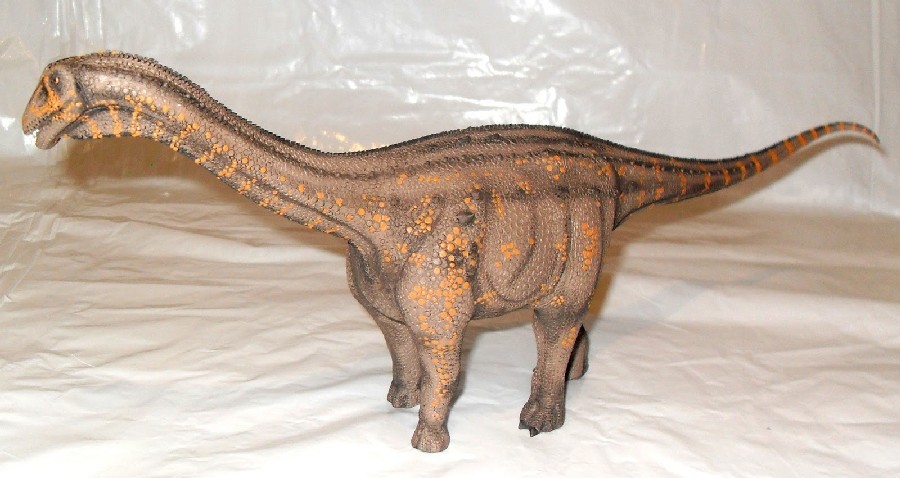Baurutitan
- Brazil, Minas Gerais (Marília Formation)
- Baurutitan britoi
Baurutitan is a genus of sauropod dinosaur from the group of Titanosauria from the Late Cretaceous ( Maastrichtian upper ) of South America. So far, only one caudal vertebrae series known, was found in the layers of the Marília Formation ( Bauru Group) in the Brazilian state of Minas Gerais. The only way is Baurutitan britoi.
Features
Like all sauropods had Baurutitan a large, four-legged running herbivore with a long neck and tail and a barrel-shaped body. The caudal vertebrae show different diagnostic characteristics, the unique combination of these features is used to distinguish the genus from other genera. For example, the first caudal vertebra was on both sides convex. The spinous processes of the anterior caudal vertebrae were tilted backwards while they were oriented more vertically from the fifth lumbar vertebrae. The genus also can distinguish the vertebral arches of other genera by two unique features ( autapomorphies ): So the first caudal vertebra shows a tapered laterally oriented ridge, which interrupts the Spinoprezygapophyseal lamina. Furthermore, was the Spinoprezygapophyseal lamina oriented anterolateral.
System
The phylogenetic relationships of Baurutitan within the Titanosauria are unclear. The first described by Alexander Kellner have asked the genus to the Titanosauridae. This family is considered by many researchers as invalid because it is based on Titanosaurus as nominotypisches taxon, but showing no diagnostic features. Baurutitan belonged neither to the most primitive ( basal ) is still the most modern ( abgeleitesten ) Titanosauria: So the middle caudal vertebrae were different greatly procoel than original Titanosauria as Andesaurus, a derived feature. On the other hand, lacked certain features of the highly derived Saltasaurinen, such as the anterior caudal vertebrae, which are much wider than high at Saltasaurinen. Baurutitan shows similarities with Aeolosaurus, Gondwana titanium and with Alamosaurus.
Fund, history of discovery and naming
The only known Fund comes from the Caieira quarry about two kilometers north of Peirópolis near Uberaba. Excavations took place in this quarry from 1949 to 1961 and brought alongside the sauropod remains of the remains of turtles, crocodiles, theropods, fish, invertebrates and plants out. In the quarry are fine to medium grained sandstones open from white to yellow in color. These rocks belong to the Serra da galga Members, a layer link in the Marília Formation, which at the most recent time unit of the Upper Cretaceous (late Maastrichtian ) is dated. The Marília Formation is the uppermost of the two formations of the Bauru Group.
The Fund ( holotype, specimen number MCT 1490 -R ) consists of the last sacral vertebra and a series of 18 caudal vertebrae that articulates were found ( in the network). These vertebrae are well preserved, almost undeformed and almost completely. The fossils are now in the Natural History Museum (Museu de Ciências da Terra ) of the Departamento Nacional de Produção kept mineral. Baurutitan was described in 2005 by Alexander Kellner and colleagues first. The name Baurutitan alludes to the Bauru Group, the rock unit from which originate the fossils. The ending titan is derived from the Titans of Greek mythology. The Artepitheth britoi honors Ignacio Machado Aureliano Brito, an important Brazilian paleontologists.
Documents
Main source
- AWA Kellner, D. d A. Campos, MNF Trotta, 2005: Description of a titanosaurid caudal series from the Bauru Group, Late Cretaceous of Brazil. In: Arquivos do Museu Nacional, Rio de Janeiro, 63, 3, pages 529-564










